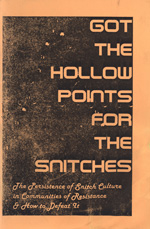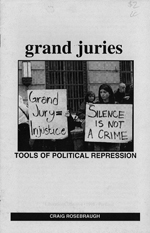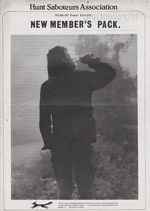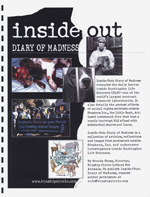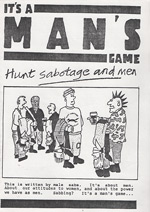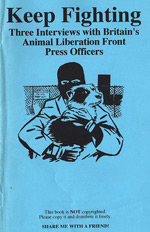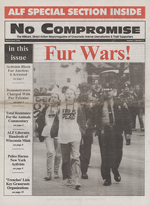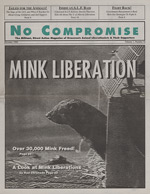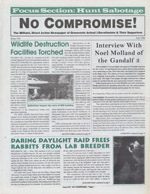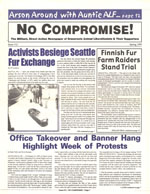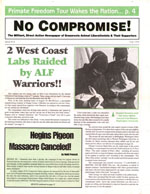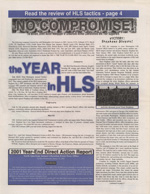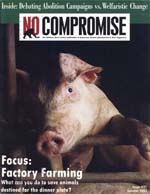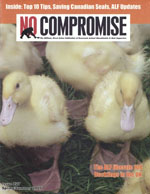Got the Hollowpoints for the Snitches (2005, City of publication unknown. USA) An examination of the consequences of activists who provide evidence to the state written during the Green Scare. Comes complete with a rogues gallery of traitors. Our least controversial publication!
Grand Juries: Tools of Political Repression (1998. Portland, OR. USA) After his first few subpoenas, Craig Rosebraugh wrote this essay just in time to receive six more subpoenas. The tone of the publication is a little heavy handed, academic, and politically naive, but contains a good overview of grand juries.
Homo Milk (1992. Sacramento, CA, USA) A true treasure produced by Tom Scut and Todd Pollution Circus. Super queer, super vegan, and very influential in its time.
Hunt Saboteurs Association New Members Pack (1987. Exeter, England.) The Hunt Saboteurs Association is among the most important organizations in the history of animal rights. Starting in 1963, it was one of the first protest organizations for animals in the modern era. Its means were always direct action oriented, and many of our greatest organizations, activists, and philosophies originated with HSA participation. This New Members Pack is a great place to start learning abut the early tactics of the group.
Inside / Out: Diary of Madness (2001. St. Louis, MO. USA) Inside / Out is the story of Brenda Shoss’ experience at the national demonstration which took place in Little Rock between October 27th and 29th in 2001. Brenda, a devoted animal rescuer and mother, represented the broad diversity of the campaign against Huntingdon Life Sciences during its early years. She hardly fit the image of militant campaigning. Happily marching alongside pierced punks and anarchists, Brenda’s mild mannered and patriotic politics did not clash with those held by her comrades: instead her presence signaled a movement able to break through to a wider audience. Throughout her account of the demonstrations she evokes the anger and outrage that prompted thousands to band together, despite their differences, to fight to shut down HLS.
Inside the Cages: animal liberation and imprisonment (2013. South London, England) lewis pogson’s account of his imprisonment in England for animal liberation actions. The final chapters deal with post-release supervision and are a must read for those trying to understand the long term legal consequences of a serious arrest.
It’s a Man’s Game (Publication year unknown, likely early 1980s. Leeds, England) It’s A Man’s Game is a short zine written after an anarchist men’s weekend, outlining what they perceived as sexism in the UK’s Hunt Saboteur Association. The authors argue that all men involved in hunt sabbing engage in behaviors that oppress women, and that women and animals are alike because women are “enslaved as wives” and “used for entertainment, cheap labour, and sex.”
For a zine claimed to be inspired by women’s strength, it is notably absent of evidence of women voicing their own concerns with the sabbing scene. Instead, women are portrayed as yet another helpless and oppressed creature that needs protecting by enlightened men – mirroring the paternalistic dynamic of how many animal rights activists view animals.
The solutions to sexism proposed by the zine are to disassociate with the HSA, have structured meetings to prevent any one person from talking more than another, and to spend time doing blindfolded trust exercises as a group to build respect for women.
Keep Fighting: Three Interviews with Britain’s Animal Liberation Front Press Officers (1996. Minneapolis, MN. USA) An almost entirely fantastic little zine containing three highly influential interviews with Robin Webb, Ronnie Lee, and Robin Lane covering the arguments in favor of direct action. There are, however, some arguments on human population in Lee’s interview that will disappoint.
Let’s Get Free (2002. Eugene, OR. USA) Let’s Get Free tells the story of Jeff “Free” Luers’ arrest, trial, and sentencing, along with some short articles and illustrations by Jeff himself. It was sold to benefit his legal defense and prison commissary fund before he eventually had his sentence reduced from 22 years to about 10 years on appeal. It manages to capture some of the shock and anger felt by the activist community when one of our best comrades was buried inside the prison system as a reminder to stay in our place. What it doesn’t capture is the strength, sincerity, and warmth of Jeff Luers. The state failed to tame this warrior. Free is free!

